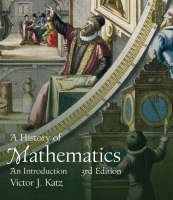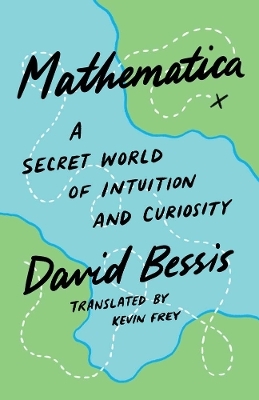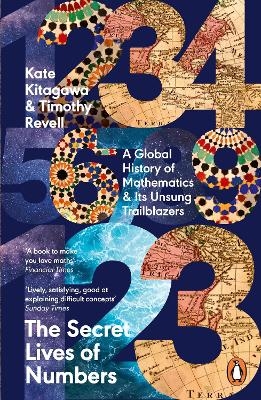
A History of Mathematics
Pearson (Verlag)
978-0-321-38700-4 (ISBN)
- Titel erscheint in neuer Auflage
- Artikel merken
This book is ideal for a junior or senior level course in the history of mathematics for mathematics majors intending to become teachers.
Victor J. Katz received his PhD in mathematics from Brandeis University in 1968 and has been Professor of Mathematics at the University of the District of Columbia for many years. He has long been interested in the history of mathematics and, in particular, in its use in teaching. He is the editor of The Mathematics of Egypt, Mesopotamia, China, India and Islam: A Sourcebook (2007). He has edited or co-edited two recent books dealing with this subject, Learn from the Masters (1994) and Using History to Teach Mathematics (2000). Dr. Katz also co-edited a collection of historical articles taken from MAA journals of the past 90 years, Sherlock Holmes in Babylon and other Tales of Mathematical History. He has directed two NSF-sponsored projects to help college teachers learn the history of mathematics and learn to use it in teaching. Dr. Katz has also involved secondary school teachers in writing materials using history in the teaching of various topics in the high school curriculum. These materials, Historical Modules for the Teaching and Learning of Mathematics, have now been published by the MAA. Currently, Dr. Katz is the PI on an NSF grant to the MAA that supports Convergence, an online magazine devoted to the history of mathematics and its use in teaching.
Part I. Ancient Mathematics
1. Egypt and Mesopotamia
1.1 Egypt
1.2 Mesopotamia
2. The Beginnings of Mathematics in Greece
2.1 The Earliest Greek Mathematics
2.2 The Time of Plato
2.3 Aristotle
3. Euclid
3.1 Introduction to the Elements
3.2 Book I and the Pythagorean Theorem
3.3 Book II and Geometric Algebra
3.4 Circles and the Pentagon
3.5 Ratio and Proportion
3.6 Number Theory
3.7 Irrational Magnitudes
3.8 Solid Geometry and the Method of Exhaustion
3.9 Euclid’s Data
4. Archimedes and Apollonius
4.1 Archimedes and Physics
4.2 Archimedes and Numerical Calculations
4.3 Archimedes and Geometry
4.4 Conic Sections Before Apollonius
4.5 The Conics of Apollonius
5. Mathematical Methods in Hellenistic Times
5.1 Astronomy Before Ptolemy
5.2 Ptolemy and The Almagest
5.3 Practical Mathematics
6. The Final Chapter of Greek Mathematics
6.1 Nichomachus and Elementary Number Theory
6.2 Diophantus and Greek Algebra
6.3 Pappus and Analysis
Part II. Medieval Mathematics
7. Ancient and Medieval China
7.1 Introduction to Mathematics in China
7.2 Calculations
7.3 Geometry
7.4 Solving Equations
7.5 Indeterminate Analysis
7.6 Transmission to and from China
8. Ancient and Medieval India
8.1 Introduction to Mathematics in India
8.2 Calculations
8.3 Geometry
8.4 Equation Solving
8.5 Indeterminate Analysis
8.6 Combinatorics
8.7 Trigonometry
8.8 Transmission to and from India
9. The Mathematics of Islam
9.1 Introduction to Mathematics in Islam
9.2 Decimal Arithmetic
9.3 Algebra
9.4 Combinatorics
9.5 Geometry
9.6 Trigonometry
9.7 Transmission of Islamic Mathematics
10. Medieval Europe
10.1 Introduction to the Mathematics of Medieval Europe
10.2 Geometry and Trigonometry
10.3 Combinatorics
10.4 Medieval Algebra
10.5 The Mathematics of Kinematics
11. Mathematics Elsewhere
11.1 Mathematics at the Turn of the Fourteenth Century
11.2 Mathematics in America, Africa, and the Pacific
Part III. Early Modern Mathematics
12. Algebra in the Renaissance
12.1 The Italian Abacists
12.2 Algebra in France, Germany, England, and Portugal
12.3 The Solution of the Cubic Equation
12.4 Viete, Algebraic Symbolism, and Analysis
12.5 Simon Stevin and Decimal Analysis
13. Mathematical Methods in the Renaissance
13.1 Perspective
13.2 Navigation and Geography
13.3 Astronomy and Trigonometry
13.4 Logarithms
13.5 Kinematics
14. Geometry, Algebra and Probability in the Seventeenth Century
14.1 The Theory of Equations
14.2 Analytic Geometry
14.3 Elementary Probability
14.4 Number Theory
14.5 Projective Geometry
15. The Beginnings of Calculus
15.1 Tangents and Extrema
15.2 Areas and Volumes
15.3 Rectification of Curves and the Fundamental Theorem
16. Newton and Leibniz
16.1 Isaac Newton
16.2 Gottfried Wilhelm Leibniz
16.3 First Calculus Texts
Part IV. Modern Mathematics
17. Analysis in the Eighteenth Century
17.1 Differential Equations
17.2 The Calculus of Several Variables
17.3 Calculus Texts
17.4 The Foundations of Calculus
18. Probability and Statistics in the Eighteenth Century
18.1 Theoretical Probability
18.2 Statistical Inference
18.3 Applications of Probability
19. Algebra and Number Theory in the Eighteenth Century
19.1 Algebra Texts
19.2 Advances in the Theory of Equations
19.3 Number Theory
19.4 Mathematics in the Americas
20. Geometry in the Eighteenth Century
20.1 Clairaut and the Elements of Geometry
20.2 The Parallel Postulate
20.3 Analytic and Differential Geometry
20.4 The Beginnings of Topology
20.5 The French Revolution and Mathematics Education
21. Algebra and Number Theory in the Nineteenth Century
21.1 Number Theory
21.2 Solving Algebraic Equations
21.3 Symbolic Algebra
21.4 Matrices and Systems of Linear Equations
21.5 Groups and Fields — The Beginning of Structure
22. Analysis in the Nineteenth Century
22.1 Rigor in Analysis
22.2 The Arithmetization of Analysis
22.3 Complex Analysis
22.4 Vector Analysis
23. Probability and Statistics in the Nineteenth Century
23.1 The Method of Least Squares and Probability Distributions
23.2 Statistics and the Social Sciences
23.3 Statistical Graphs
24. Geometry in the Nineteenth Century
24.1 Differential Geometry
24.2 Non-Euclidean Geometry
24.3 Projective Geometry
24.4 Graph Theory and the Four Color Problem
24.5 Geometry in N Dimensions
24.6 The Foundations of Geometry
25. Aspects of the Twentieth Century
25.1 Set Theory: Problems and Paradoxes
25.2 Topology
25.3 New Ideas in Algebra
25.4 The Statistical Revolution
25.5 Computers and Applications
25.6 Old Questions Answered
| Erscheint lt. Verlag | 18.8.2008 |
|---|---|
| Sprache | englisch |
| Maße | 209 x 234 mm |
| Gewicht | 1570 g |
| Themenwelt | Mathematik / Informatik ► Mathematik ► Geschichte der Mathematik |
| ISBN-10 | 0-321-38700-7 / 0321387007 |
| ISBN-13 | 978-0-321-38700-4 / 9780321387004 |
| Zustand | Neuware |
| Haben Sie eine Frage zum Produkt? |
aus dem Bereich



